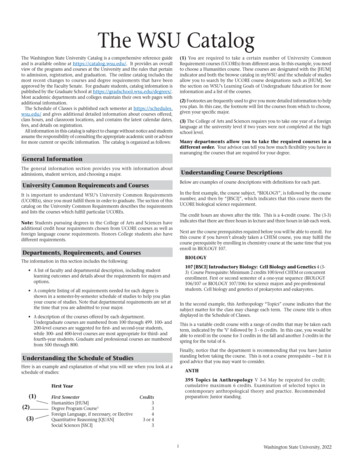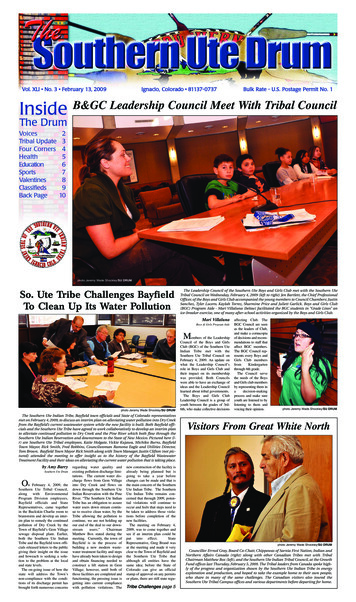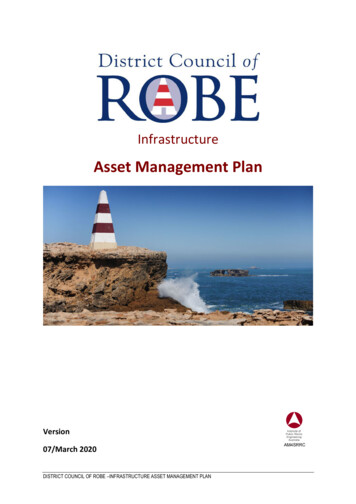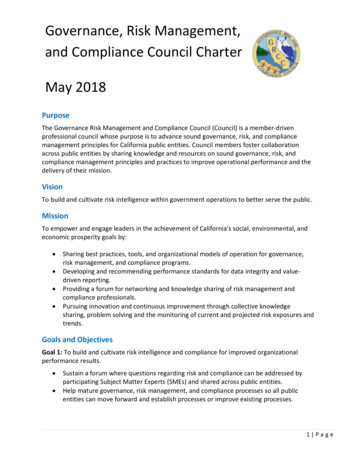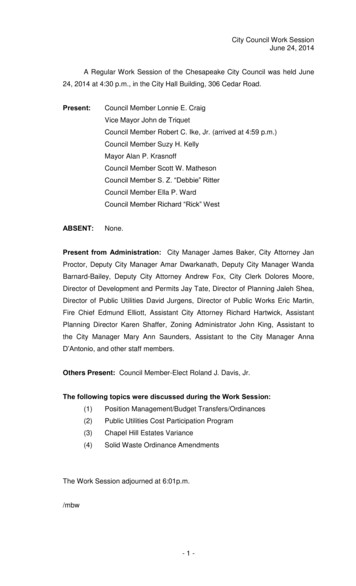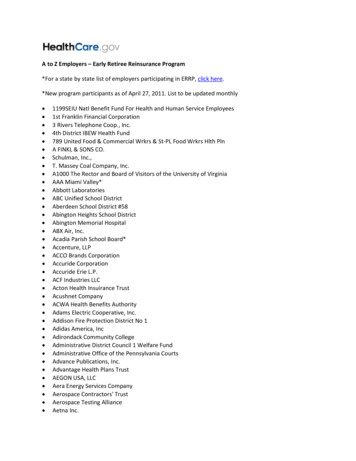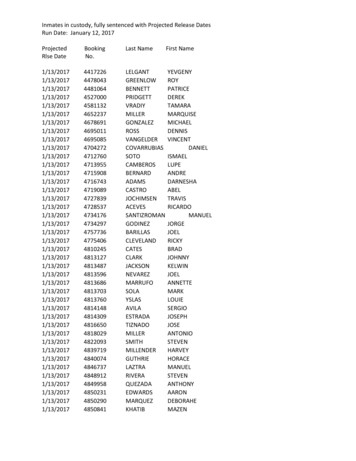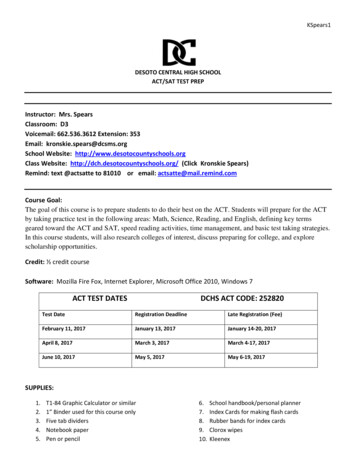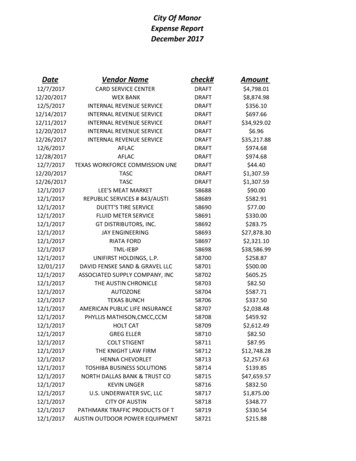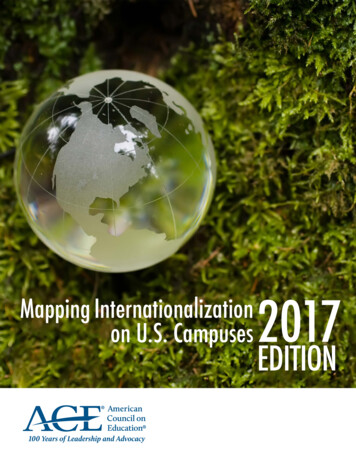
Transcription
Mapping Internationalizationon U.S. Campuses100 Years of Leadership and Advocacy2017EDITION
100 Years of Leadership and AdvocacyACE and the American Council on Education are registered marks of the American Council on Education and may notbe used or reproduced without the express written permission of ACE.American Council on EducationOne Dupont Circle NWWashington, DC 20036 2017. All rights reserved. No part of this publication may be reproduced or transmitted in any form or by any meanselectronic or mechanical, including photocopying, recording, or by any information storage and retrieval system, without permission in writing from the publisher.
Mapping Internationalization on U.S. Campuses:2017 EditionRobin Matross HelmsDirectorCenter for Internationalization and Global EngagementLucia BrajkovicSenior Research SpecialistCenter for Internationalization and Global EngagementData analysis by:Brice StruthersAssociate Academic Innovation SpecialistCenter for Education Attainment and Innovation
About the SponsorACE is grateful for the generous support of Navitas, which sponsored the production of this report and thedissemination of the Mapping findings.For more than 20 years, Navitas has partnered with more than 30 universities worldwide to increase international students’ access to higher education and prepare them for future success. Through these partnerships,Navitas endeavors to help institutions: Transform enrollment by recruiting, transitioning, and retaining a greater number and more diversecommunity of international students; Raise the institution’s global profile and increase its international competitiveness; Enhance the international and domestic student experience and broaden global perspectives acrossthe entire campus community and beyond; Increase the probability of success for international students by developing specialized acclimationand transition programs; and Generate significant and sustainable new revenue streams for reinvestment in key areas of the institution.Navitas’ North American university partners include Simon Fraser University (Canada), University of Manitoba(Canada), University of Massachusetts Lowell, University of Massachusetts Dartmouth, University of Massachusetts Boston, University of New Hampshire, Florida Atlantic University, University of Idaho, and Richard BlandCollege of William and Mary (VA). More information can be found at www.navitas.com.About the Center for Internationalization and Global EngagementACE’s Center for Internationalization and Global Engagement (CIGE) helps institutions develop and sustaincomprehensive, effective internationalization programs that increase global engagement for students, facultyand staff. We believe effective internationalization goes beyond traditional study abroad programs and international student enrollment. It requires a comprehensive institutional commitment that also includes curriculum,research, faculty development, and active strategies for institutional engagement. In addition, CIGE monitorsand analyzes global trends in higher education in cooperation with other education associations around world.
ContentsAcknowledgments. . . . . . . . . . . . . . . . . . . . . . . . . . . . . . . . . . . . . . . . . . . . . . . . . . . . . . . . . . . . . . . . . . . . . . . . . . . . . . . vExecutive Summary. . . . . . . . . . . . . . . . . . . . . . . . . . . . . . . . . . . . . . . . . . . . . . . . . . . . . . . . . . . . . . . . . . . . . . . . . . . . . . viiIntroduction . . . . . . . . . . . . . . . . . . . . . . . . . . . . . . . . . . . . . . . . . . . . . . . . . . . . . . . . . . . . . . . . . . . . . . . . . . . . . . . . . . . 1The Survey Findings. . . . . . . . . . . . . . . . . . . . . . . . . . . . . . . . . . . . . . . . . . . . . . . . . . . . . . . . . . . . . . . . . . . . . . . . . . . . . . 5Articulated Institutional Commitment. . . . . . . . . . . . . . . . . . . . . . . . . . . . . . . . . . . . . . . . . . . . . . . . . . . . . . . . . . . . . . 7Administrative Leadership, Structure, and Staffing . . . . . . . . . . . . . . . . . . . . . . . . . . . . . . . . . . . . . . . . . . . . . . . . . . . . 10Curriculum, Co-curriculum, and Learning Outcomes. . . . . . . . . . . . . . . . . . . . . . . . . . . . . . . . . . . . . . . . . . . . . . . . . . . . 14Faculty Policies and Practices. . . . . . . . . . . . . . . . . . . . . . . . . . . . . . . . . . . . . . . . . . . . . . . . . . . . . . . . . . . . . . . . . . 20Student Mobility. . . . . . . . . . . . . . . . . . . . . . . . . . . . . . . . . . . . . . . . . . . . . . . . . . . . . . . . . . . . . . . . . . . . . . . . . . . 25Collaboration and Partnerships . . . . . . . . . . . . . . . . . . . . . . . . . . . . . . . . . . . . . . . . . . . . . . . . . . . . . . . . . . . . . . . . . 32Looking Forward. . . . . . . . . . . . . . . . . . . . . . . . . . . . . . . . . . . . . . . . . . . . . . . . . . . . . . . . . . . . . . . . . . . . . . . . . . . . . . . 38References . . . . . . . . . . . . . . . . . . . . . . . . . . . . . . . . . . . . . . . . . . . . . . . . . . . . . . . . . . . . . . . . . . . . . . . . . . . . . . . . . . . 41Appendix: Methodology . . . . . . . . . . . . . . . . . . . . . . . . . . . . . . . . . . . . . . . . . . . . . . . . . . . . . . . . . . . . . . . . . . . . . . . . . . 43
AcknowledgmentsThe authors gratefully acknowledge the contributions of a number of colleagues to this report. Jermain Griffin,Heather Ward, Brad Farnsworth, Barbara Hill, Lisa Motley, and other staff in the American Council on Education (ACE) Center for Internationalization and Global Engagement assisted with survey design and reportediting, and provided intellectual and moral support throughout the project.Jonathan M. Turk in ACE’s Center for Policy Research and Strategy guided data analysis, and helped ensurethat our narrative accurately reflects the numbers. Ronald Matross provided valuable advice on questionformulation and survey design. An intrepid group of George Washington University (DC) graduate studentsassisted with data entry: Arielle Gousse, Richard Owens, Erya Zhao, and Joy Zhou. Manuel S. González Canché,associate professor at the University of Georgia, supplied additional expertise on data analysis techniques,while Chris R. Glass, assistant professor at Old Dominion University (VA), brought a crucial scholarly andpractitioner perspective to the editing process.Lindsay Addington, Rahul Choudaha, Clay Hensley, Yoko Kono, and Dawn Michele Whitehead wrote text for“Related Research” boxes featured in the report. Their contributions complement the report’s findings and addvaluable detail to the overall picture of internationalization painted by the data.ACE’s J’Nai Baylor and Sujay Bharati helped with list management and survey distribution. Sarah Zogby andAlly Hammond brought their considerable creativity and expertise to bear on the design of the report, whilethe rest of ACE’s Publications team corrected our typos and inelegant language. Former ACE colleagues PattiMcGill Peterson, Christopher J. Nellum, Lucia Greve, and Prashant Shrestha also contributed to the project.Finally, this report would not be possible without the individuals who completed the Mapping Survey on behalfof the 1,164 participating colleges and universities—we are deeply appreciative of their time and insights.American Council on Education v
Executive SummaryMapping Internationalization on U.S. Campuses is a signature project of the American Council on Education(ACE) Center for Internationalization and Global Engagement (CIGE). Conducted every five years, Mappingassesses the current state of internationalization at American colleges and universities, analyzes progress andtrends over time, and identifies future priorities.The 2016 Mapping Survey—like the three previous iterations—addressed the six key areas that make up theCIGE Model for Comprehensive Internationalization: articulated commitment; administrative structures andstaffing; curriculum, co-curriculum, and learning outcomes; faculty policies and practices; student mobility; andcollaboration and partnerships. Key findings include: Institutions are optimistic about their internationalization progress. Nearly three-quarters (72 percent) of respondents indicated that internationalization accelerated in recent years, and the proportion of institutions reporting “high” or “very high” levels of internationalization rose from just overone-fifth in 2011 to 30 percent in 2016. Internationalization is increasingly an administrative-intensive endeavor, coordinated by a singleoffice and/or a senior international officer. More institutions are implementing policies, procedures,and planning processes to guide internationalization efforts. In-house models dominate when it comes to resources for internationalization and the managementof activities and programs. However, a notable proportion of institutions are also engaging withoutside entities (e.g., third-party program providers, funders, and international partners) to furthersupport and supplement internal efforts. While student mobility has consistently been a focus of internationalization efforts, the 2016 dataindicate an increasingly sharp emphasis on this area relative to other aspects of internationalization.This is reflected in stated priorities, as well as resource allocations for education abroad and international student recruiting—including a marked increase in the percentage of institutions that engageoverseas student recruiters. The level of support international students receive once they arrive oncampus, while trending upward, remains a concern. Though the curriculum and co-curriculum take a backseat to student mobility in terms of statedpriorities for internationalization, an increasing percentage of institutions are implementing academic and co-curricular policies and programming that facilitate on-campus global learning on abroader scale and among a broader base of students. More institutions are offering internationally focused professional development opportunities forfaculty; however, still only about one in 10 specify international engagement as a consideration in promotion and tenure decisions. Overall, the faculty-related data raise questions about the recognitionof faculty as key drivers of internationalization. International partnerships and activities abroad are garnering increased attention, energy, andsupport on many campuses. However, there is still a wide spectrum in terms of activity levels, as wellas the extent of planning and intentionality surrounding global engagement.American Council on Education vii
Consistent with the 2001, 2006, and 2011 data, there are notable differences by Carnegie Classification in terms of internationalization progress and focus. While doctoral institutions continue to leadoverall, a number of indicators suggest that their progress has plateaued in certain areas. Associateand special focus institutions, in contrast, have seen considerable advances in many areas, particularlywhen it comes to the curriculum.Finer-grained data on the practice of internationalization—as operationalized through policies, programs,and activities—shed additional light on the realities of how internationalization is playing out on campuses,and paint a more complex picture when it comes to progress and trends over time. Mirroring the structureof the survey instrument, subsequent sections of this report explore in detail the data for each pillar ofthe CIGE Model for Comprehensive Internationalization, and their implications for the overall state ofinternationalization nationwide. Notable differences by Carnegie Classification are included as relevant on anindicator-by-indicator basis.New in 2017, the report includes additional analyses for different segments of U.S. higher education, as well asinformation about studies conducted by ACE and other organizations that complement the Mapping Surveydata. The conclusion summarizes the overall landscape of internationalization, offers suggestions for additionalresearch, and highlights areas—in particular, the curriculum and faculty professional development—that requireadditional attention and effort as institutions pursue a comprehensive approach to internationalization.viii Mapping Internationalization on U.S. Campuses: 2017 Edition
IntroductionWelcome to the 2017 edition of Mapping Internationalization on U.S. Campuses.Now in its fourth iteration, Mapping is the only comprehensive study of U.S. higher education internationalization. Conducted every five years, it assesses the current state of internationalization at American colleges anduniversities, analyzes progress and trends over time, and identifies future priorities. The Mapping Survey isadministered to colleges and universities nationwide, representing all sectors of U.S. higher education.With data spanning two decades, Mapping is the signature research project of ACE’s Center for Internationalization and Global Engagement (CIGE). CIGE provides in-depth analysis of critical international educationissues and administers programs and services to support higher education institutions’ internationalizationand global engagement strategies.A core principle underpinning CIGE’s research and programs is “comprehensive internationalization,” definedby CIGE as “a strategic, coordinated process that seeks to align and integrate international policies, programs,and initiatives, and positions colleges and universities as more globally oriented and internationally connectedinstitutions.” This process requires a clear commitment by top-level institutional leaders, meaningfully impactsthe curriculum and a broad range of stakeholders, and results in deep and ongoing incorporation of international perspectives and activities throughout the institution.The Mapping study is structured around the CIGE Model for Comprehensive Internationalization, illustratedin Figure 1, which consists of six pillars delineating key areas that together constitute a comprehensive internationalization approach: Articulated institutional commitment: Mission statements; strategic plans; funding allocation; formal assessment mechanisms Administrative structure and staffing: Reporting structures; staff and office configurations Curriculum, co-curriculum, and learning outcomes: General education and language requirements;co-curricular activities and programs; specified student learning outcomes Faculty policies and practices: Hiring guidelines; tenure and promotion policies; faculty developmentopportunities Student mobility: Education abroad programs; international student recruitment and support Collaboration and partnerships: Institutional partnerships; joint degree and dual/double degree programs; branch campuses; other offshore programsAmerican Council on Education 1
Figure 1. CIGE Model for Comprehensive mentAdministrativeleadership,structure, andstaffingCurriculum, cocurriculum, andlearning outcomesFaculty policiesand practicesStudentmobilityCollaboration andpartnershipsCOMPREHENSIVE INTERNATIONALIZATIONAn important feature of the CIGE Model is the arrow that runs along the bottom, illustrating the interconnectedness of the individual pillars. Progress (or lack thereof) in one area impacts what can be achieved in theothers. Previous Mapping reports—and subsequent sections of this one—explore these interconnections, as wellas the implications of data in one pillar in terms of potential opportunities and challenges in other areas.Institutions’ approaches to internationalization are—and should be—different based on their unique circumstances and goals. However, a broad examination across these categories at colleges and universities nationwide provides a useful picture of collective progress toward the ideal of comprehensive internationalization,recent successes and emerging challenges, and areas that merit a sharper focus by institutions, as well aspolicymakers, researchers, and practitioners in the international education field.2 Mapping Internationalization on U.S. Campuses: 2017 Edition
The 2016 SurveyIn a longitudinal survey project, a key challenge is to maintain a balance between the consistency that allowsfor meaningful comparisons over time, and updates that reflect new issues and developments in the field. Forthe 2016 Mapping Survey, we sought this balance by maintaining the basic structure of the survey, based on theCIGE Model for Comprehensive Internationalization, but refining the wording of certain questions, eliminatingitems that were no longer relevant, and adding new content to address emerging topics of interest. Noteworthychanges include: We used the term “education abroad” instead of “study abroad.” Sometimes accepted terminologyseems to change just for the sake of change, but in this case we think the nuances are important.“Education abroad” accounts for service learning, internships, research experiences, and other nonclassroom-based activities that take students to other countries and contribute to their learning anddevelopment. We also asked specific questions to gauge the prevalence and priority of these variouseducation abroad activities. Our questions about international engagement and partnerships were more detailed. In 2001, relationships with counterparts abroad were barely on the internationalization radar for most institutions.Now, though, partnerships are much more common, and many colleges and universities are focusingon how best to utilize these arrangements to advance institutional priorities. Among other relatedissues, the new survey addressed strategic planning for partnerships; whether institutions have a physical presence in another country and what form it takes; and whether they have created a partnershipdirector position to manage global engagement activities. We disaggregated information on funding trends by source. A somewhat surprising finding fromthe last Mapping Survey was that between 2006 and 2011—a time when the recession was wreakinghavoc on campus budgets nationwide—overall funding for internationalization remained relativelystable. In the 2016 survey, we sought to better understand the funding mix that underpins internationalization initiatives, including internal institutional support, government (state, federal, and international) grants, alumni giving, and other private donations, as well as how these funding levels havechanged in recent years. The survey addressed emerging support structures for international students. To supplementquestions about academic support structures and co-curricular activities, we added questions about intensive English and “pathway” programs, which are gaining visibility as a way to smooth internationalstudents’ transition to the United States and facilitate academic and social integration.Perhaps most importantly, we streamlined the survey and avoided asking respondents to provide informationthat is available from other sources. Rather than reinventing the wheel, we have incorporated relevant additional data into subsequent sections of this report.Data collection was a multistage process. We initially sent the Mapping Survey to chief academic officers/provosts in February 2016. Throughout the subsequent nine months, we followed up with senior internationalofficers, institutional researchers, and presidents. In the end, we received a total of 1,164 valid survey responsesfrom colleges and universities nationwide, for an overall response rate of 39.5 percent—the highest ever acrossthe four iterations of the survey, both in terms of the number of surveys received and the response rate.American Council on Education 3
About This ReportIn presenting the Mapping findings, we start with the key takeaways—the overall conclusions that result froma broad analysis across the full spectrum of data. From there, we drill down into the more nuanced data in eacharea of the CIGE Model, and examine the specifics of how particular aspects of internationalization are playingout on college and university campuses.Finally, we look toward the future, and consider the implications of the 2016 data in terms of where internationalization is headed, and which areas merit additional attention, resources, and research; as part of this analysis, we also consider recent political developments and the overall climate for internationalization efforts.Throughout the report we have included feature boxes with additional information that supplements the primary narrative: “Sector Snapshot” boxes provide summaries of the 2016 data for particular segments of U.S. highereducation. As in past Mapping reports, we highlight variations by Carnegie Classification throughoutthe report. For this edition, however, we also analyzed differences along other dimensions, as definedby IPEDS1: minority serving, control (public versus private), and “urbanicity” (city, suburb, town, rural). “Data Drill-Down” boxes highlight follow-on research to the 2011 Mapping Survey that further explores key findings of the previous study. Topics include internationalization of tenure and promotionpolicies, joint and dual degree programs, and good practices for international partnerships. “Related Research” boxes complement the data with relevant information from studies conductedby other organizations and experts in the international education field. They are intended to help usmap internationalization beyond what is captured in our own research, and add additional detail to theoverall internationalization picture.In addition: The report’s Appendix provides additional methodological details of the study, including surveydistribution strategies and data analysis techniques. As in previous iterations, we weighted the data sothat it represents the overall makeup of U.S. higher education by Carnegie Classification; the Appendixalso explains our weighting scheme. The full Mapping Survey data set in table format—2016 data by Carnegie Classification and longitudinal comparisons across the four iterations of the survey—are available online atwww.acenet.edu/mapping.The Mapping report is intended to serve a variety of purposes for different audiences. For on-campus internationalization leaders and practitioners, it provides a basis for benchmarking, and understanding how theirinstitutions compare to counterparts nationwide. CIGE uses the findings to inform our research agenda andprogrammatic content in subsequent years; by highlighting key topics for further exploration, our hope is thatother organizations, researchers, and practitioners will contribute to follow-on research and activities as well.Most broadly, Mapping represents a key contribution by ACE to national and international policy conversations aimed at advancing the internationalization agenda both in the U.S. and around the world.1The Integrated Postsecondary Education Data System (IPEDS) is a system of interrelated surveys conducted annuallyby the National Center for Education Statistics (NCES), a part of the Institute of Education Sciences within the U.S.Department of Education: https://nces.ed.gov/ipeds.4 Mapping Internationalization on U.S. Campuses: 2017 Edition
The Survey FindingsAt the broadest level, the 2016 Mapping Survey data indicate that internationalization continues to gainmomentum among U.S. colleges and universities. In terms of the pace of progress, nearly three-quarters (72 percent) of respondents indicated that internationalization accelerated in recent years, compared to 64 percentin 2011. And as illustrated in Figure 2, the proportion of institutions reporting “high” or “very high” levels ofinternationalization increased from just over one-fifth in 2011 to 29 percent in 2016. The percentage indicating“low” or “very low” internationalization levels, in contrast, fell 11 percentage points since the last iteration of thesurvey.Figure 2. Reported overall level of institutional internationalization in recent yearsVery highHigh20116 152016821ModerateLowVery low352222372013As in 2011, “improving student preparedness for a global era” is front and center among institutions’ reasonsfor internationalizing, followed by “diversifying students, faculty, and staff at the home campus,” and “becoming more attractive to prospective students at home and overseas.” Revenue generation holds the numberfour spot (up from number six in 2011), indicating an increased (or at least more overt) focus on this as a goal.Increasing study abroad and recruiting international students are first and second, respectively, when it comesto priority activities for internationalization, followed by developing partnerships with institutions and organizations abroad, internationalizing the curriculum/co-curriculum, and faculty development.PRIORITY ACTIVITIES FOR INTERNATIONALIZATION#1: Increasing study abroad for U.S. students#2: Recruiting international students#3: Partnerships with institutions abroad#4: Internationalizing the curriculum/co-curriculum#5: Faculty developmentAmerican Council on Education 5
Looking beyond perceived internationalization levels and stated priorities, the 2016 data reveal a number of keytrends that add detail and nuance to the overall internationalization picture. These include: Internationalization is increasingly an administrative-intensive endeavor, coordinated by a singleoffice and/or a senior international officer. More institutions are implementing policies, procedures,and planning processes to guide internationalization efforts. In-house models dominate when it comes to resources for internationalization and the managementof activities and programs. However, a notable proportion of institutions are also engaging withoutside entities (e.g., third-party program providers, funders, and international partners) to furthersupport and supplement internal efforts. While student mobility has consistently been a focus of internationalization efforts, the 2016 dataindicate an increasingly sharp emphasis on this area relative to other aspects of internationalization.This is reflected in stated priorities, as well as resource allocations for education abroad and international student recruiting—including a marked increase in the percentage of institutions that engageoverseas student recruiters. The level of support that international students receive once they arrive oncampus, while trending upward, remains a concern. Though the curriculum and co-curriculum take a backseat to student mobility in terms of statedpriorities for internationalization, an increasing percentage of institutions are implementing academic and co-curricular policies and programming that facilitate on-campus global learning on abroader scale and among a broader base of students. More institutions are offering internationally focused faculty professional development opportunities; however, still only about one in 10 specify international engagement as a consideration in promotion and tenure decisions. Overall, the faculty-related data raise questions about the recognition offaculty as key drivers of internationalization. International partnerships and activities abroad are garnering increased attention, energy, andsupport on many campuses. However, there is still a wide spectrum in terms of activity levels, as wellas the extent of planning and intentionality surrounding global engagement. Consistent with the 2001, 2006, and 2011 data, there are notable differences by Carnegie Classification in terms of internationalization progress and focus. While doctoral institutions continue to leadoverall, a number of indicators suggest that their progress has plateaued in certain areas. Associateand special focus institutions, in contrast, have seen considerable advances in many areas, particularlywhen it comes to the curriculum.As in previous iterations of the Mapping Survey, finer-grained data on the practice of internationalization—asoperationalized through policies, programs, and activities—shed additional light on the realities of how internationalization is playing out on campuses, and paint a more complex picture when it comes to progress andtrends over time. The following sections explore these details, and their implications for the overall state ofinternationalization nationwide. Notable differences by Carnegie Classification are included as relevant on anindicator-by-indicator basis.6 Mapping Internationalization on U.S. Campuses: 2017 Edition
Data Drill-Down: Onward and UpwardWhile the Mapping study has evolved over time, we have maintained a core base of questions thathave been asked in every iteration of the survey. Like the overall internationalization landscape,for many of these items, there have been both steps forward and steps backward.For a handful of survey items, however, there have been steady—if sometimes modest—increasesevery five years. Taken together, these data provide a sense of some of the key focus areas anddirections of U.S. higher
the rest of ACE's Publications team corrected our typos and inelegant language. Former ACE colleagues Patti McGill Peterson, Christopher J. Nellum, Lucia Greve, and Prashant Shrestha also contributed to the project. Finally, this report would not be possible without the individuals who completed the Mapping Survey on behalf

